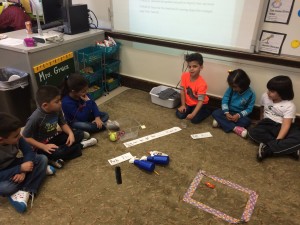Week of November 16-20
Kindergarten
Content Objective: I can demonstrate comprehension of the forces push and pull by observing and sorting objects by the force (push or pull) I used to make them move or work.
Language Objective: I can orally explain and draw something I can push and pull using sentence stems.
Sentence stem :
I can push a ________________.
I can pull a _____________
Vocabulary: force, push, pull, move, work, sorting, toward, away from
P.FM.00.31 Demonstrate pushes and pulls on objects that can move.
P.FM.00.12 Describe the direction of a moving object(for example: away from, toward).
First Grade
Content Objective: I can demonstrate comprehension of temperature measurements by observing various temperatures of water and developing a color coded thermometer that explains which degrees represent hot, warm, cool and cold.
Language Objective: I can orally explain what temperature you would feel at different degrees using my color coded thermometer and the following sentence stem:
When it is ________degrees F , it feels _________.
Vocabulary
weather, temperature, thermometer, degrees, Fahrenheit, Celsius, cool, cold, war, hot, up , down
E.ES.E.3 Weather measurement-Scientists use tools for observing, recording, and practicing weather changes.
E.ES.E.2 Weather-weather changes from day to day and over seasons.
S.IP.01.14 Manipulate simple tools (for example: thermometers) that aid observation and data collection.
Second Grade
Content Objective: I can demonstrate comprehension of how water is a natural resource by constructing a model that describes how water accumulates underground.
Language Objective: I can write to explain how water gets underground and why it is important to keep our water sources clean.
Sentence stems:
We get water under ground by________________.
It is important to keep our water sources clean because____________________________.
Vocabulary: water, sources, groundwater, wells, Earth, soil, rock, clay, sand, pollution
E.FE.E.1 Water- Water is a natural resource and is found under- ground.
E.FE.02.11 Identify water sources (wells ,springs ,rivers ,lakes, oceans)
Third Grade
Content Objective: I can demonstrate comprehension of how light travels and how a shadow can be created when light is blocked by observing and recording what happens when the light from a flashlight shines on note cards with holes.
Language Objective: I can write to explain and draw with labels how light travels and shadows can be made.
Sentence stems:
Light travels in a _____________ . I know this because____________________.
Vocabulary: light source, path of light, shadow, straight, light rays
P.EN.E.2 Light Properties-Light travels in a straight path.
P.EN.03.21 Demonstrate that light travels in a straight path and that shadows are made by placing an object in a path of light.
Fourth Grade
Content Objective: I can demonstrate comprehension of the characteristics that define the three states of matter (solid, liquid, gas) by sorting various samples of matter.
Language Objectives: I can write to explain the characteristics of each state of matter.
Sentence stems:
The characteristics that define a solid are_______________.
The characteristics that define a liquid are______________.
The characteristics that define a gas are_______________.
Vocabulary: matter, solid, liquid, gas, characteristics, mass, weight, takes up space, definite shape, volume, changes shape easily, visible, flows.
P.PM.E.1 Physical Properties- All objects and substances have physical properties that can be measured.
P.PM.E.2 States of Matter- Matter exists in several different states: solids, liquids, and gases. Each state of matter has unique physical properties. Gases are easily compressed, but liquids and solids do not compress easily. Solids have their own particular shapes, but liquids and gases take the shape of the container.
P.PM.04.23 Compare and contrast the states (solids, liquids, gases) of matter.
5th Grade
Unit-“Dynamics of the Solar System
Topic: Motion and Gravitational Force
Focus Questions: What is the motion of Earth in space? and Why doesn’t Earth fly off into space?
Content Objective: I can demonstrate application of how Earth and other planets stay in orbit by using my prior knowledge of Newton’s First Law of Motion using a ball(Earth) attached to a string(Gravitational force), and my hand (Sun) model to predict the following: what will happen when the ball is twirled above the head, if the ball(Earth) had more speed than the Gravity pulling on it, and if the ball (Earth) traveled at a slower speed.
Language Objective: I can write and draw(with labels) to explain why Earth and other planets stay in orbit around the sun.
Reflection- May use book pages 54-55 and Sentence Stems:
The Earth and other planets stay in orbit around the sun because ______________________________ .
The ball and string model demonstrated this by ____________________________________________.
*For Drawing- Draw and label the Sun, the Earth, and use arrows to show gravitational force, and the path Earth is traveling.
**Challenge**: Why do you think the moon orbits Earth?
Vocabulary: orbit, elliptical, motion, rotation, axis, revolution, force, inertia, Newton’s First Law of Motion, balanced force, unbalanced force, gravitational force, non-contact force, relative position
E.ST.M.2 Solar System Motion- Gravity is the force that keeps most objects in the solar system in regular and predictable motion.
E.ST.05.21 Describe the motion of planets and moons in terms of rotation on axis and orbits due to gravity.
P.FM.M.3 Forces have magnitude and direction. Forces can be added. The net force of an object is the sum of all the forces acting on the object. The speed or direction of the motion of the object changes when a non-zero net force is applied to it. A balanced force on an object does not change the motion of an object (the object either remains at rest or continues to move at a constant speed in a straight line)
P.FM.05.22 Demonstrate contact and non-contact forces to change motion of an object.
![IMG_2654[1]](https://iblog.dearbornschools.org/gruczl/wp-content/uploads/sites/1011/2015/11/IMG_26541-300x225.jpg)

![IMG_2659[1]](https://iblog.dearbornschools.org/gruczl/wp-content/uploads/sites/1011/2015/11/IMG_26591-300x225.jpg)
![IMG_2663[1]](https://iblog.dearbornschools.org/gruczl/wp-content/uploads/sites/1011/2015/11/IMG_26631-300x225.jpg)
![IMG_2661[1]](https://iblog.dearbornschools.org/gruczl/wp-content/uploads/sites/1011/2015/11/IMG_26611-300x225.jpg)
![IMG_2660[1]](https://iblog.dearbornschools.org/gruczl/wp-content/uploads/sites/1011/2015/11/IMG_26601-300x225.jpg)
![IMG_2671[1]](https://iblog.dearbornschools.org/gruczl/wp-content/uploads/sites/1011/2015/11/IMG_26711-300x225.jpg)
![IMG_2669[1]](https://iblog.dearbornschools.org/gruczl/wp-content/uploads/sites/1011/2015/11/IMG_26691-300x225.jpg)
![IMG_2668[1]](https://iblog.dearbornschools.org/gruczl/wp-content/uploads/sites/1011/2015/11/IMG_26681-300x225.jpg)
![IMG_2667[1]](https://iblog.dearbornschools.org/gruczl/wp-content/uploads/sites/1011/2015/11/IMG_26671-300x225.jpg)
![IMG_2666[1]](https://iblog.dearbornschools.org/gruczl/wp-content/uploads/sites/1011/2015/11/IMG_26661-300x225.jpg)
![IMG_2665[1]](https://iblog.dearbornschools.org/gruczl/wp-content/uploads/sites/1011/2015/11/IMG_26651-300x225.jpg)
![IMG_2643[1]](https://iblog.dearbornschools.org/gruczl/wp-content/uploads/sites/1011/2015/11/IMG_26431-300x225.jpg)
![IMG_2644[1]](https://iblog.dearbornschools.org/gruczl/wp-content/uploads/sites/1011/2015/11/IMG_26441-300x225.jpg)
![IMG_2641[1]](https://iblog.dearbornschools.org/gruczl/wp-content/uploads/sites/1011/2015/11/IMG_26411-300x225.jpg)
![IMG_2640[1]](https://iblog.dearbornschools.org/gruczl/wp-content/uploads/sites/1011/2015/11/IMG_26401-300x225.jpg)
![IMG_2652[1]](https://iblog.dearbornschools.org/gruczl/wp-content/uploads/sites/1011/2015/11/IMG_26521-300x225.jpg)
![IMG_2651[1]](https://iblog.dearbornschools.org/gruczl/wp-content/uploads/sites/1011/2015/11/IMG_26511-300x225.jpg)
![IMG_2658[1]](https://iblog.dearbornschools.org/gruczl/wp-content/uploads/sites/1011/2015/11/IMG_26581-300x225.jpg)
Leave a Reply